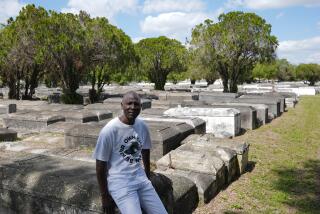Volunteers Restore History at Cemetery
- Share via
OXNARD — Somewhere in Hueneme Masonic Cemetery, beneath the weeds and ice plant, beneath the dry earth swollen by gophers, is Oxnard’s history.
City pioneers, whose names folks today would recognize from street signs, are buried in the cemetery’s overgrown plots. Now the South Oxnard Revitalization Committee is cleaning up the 101-year-old graveyard that they consider a city landmark.
On Saturday, volunteers raked the plots, carried away debris and swept off headstones. After a few more weekends of sweat and some fund-raising, organizers hope the eucalyptus-lined cemetery at Pleasant Valley and Etting roads will resemble its early years, with maintained paths and a fence surrounding it.
“We don’t know what it looked like originally,” said Christie Reischel, who has helped organize the restoration project. “There are a lot of missing headstones. It has been vandalized over the years.”
The Hueneme Masonic Cemetery was incorporated in 1898 by an association whose directors included farmer Winfield Scott Saviers and banker Achille Levy.
The oldest headstone in the two-acre graveyard dates from 1899, and the most recent burial occurred in 1964.
*
Between those years, it appears only about half of the 109 plots were used.
One small marker is believed to be the grave of a Civil War veteran.
Several others are dedicated to children who died soon after birth.
The cemetery still holds mysteries.
Many of the first to be buried there cannot be accounted for today.
Records show, for example, that blacksmith and frontiersman James Saviers, the father of W.S. Saviers, died in 1904 and was buried in Hueneme Masonic in an unmarked grave.
He may have been laid to rest with an arrowhead stuck in him, the result of an Indian attack near Sacramento decades before.
James Saviers’ body may have been among those moved from Hueneme Masonic about 1918, after the opening of Ivy Lawn Cemetery, said Eileen Tracy, who participated in Saturday’s cleanup effort and has researched the Saviers family.
A major Oxnard road is named after the early Ventura County farmers.
“Being a history buff, I just think we should be proud of our history and our roots and not neglect things like cemeteries,” Tracy said.
*
Hueneme Masonic has not been tended to regularly in about 40 years.
Oxnard-area Masons, who still control the corporation that owns the cemetery, have mowed the area once or twice a year, cleanup volunteers said.
The cemetery and the land near it have been popular spots for teenagers and their four-wheelers, said Ron Reischel, another organizer of the restoration project. A few beer cans are scattered near the graves.
The marble obelisk marking W.S. Saviers’ grave is covered in bird droppings.
About a hundred yards from Hueneme Masonic is Oxnard’s Japanese Cemetery, which is also controlled by the Hueneme Mason corporation.
It is a tiny piece of land where thin white posts painted with Japanese characters mark the graves of those once prohibited from owning land in the city.
More to Read
Sign up for Essential California
The most important California stories and recommendations in your inbox every morning.
You may occasionally receive promotional content from the Los Angeles Times.













